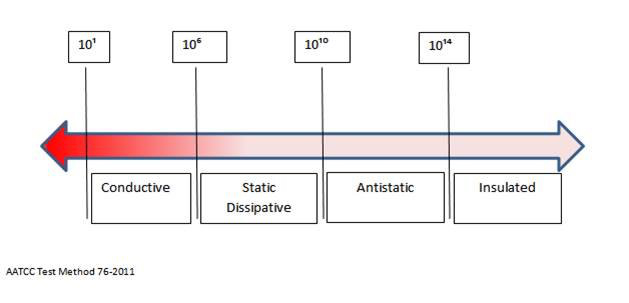A Brief Guide to Antistatic Fabrics
Over the years I have been asked if our fabrics are anti-static, conductive, or dissipative. This can be a complicated question requiring a bit a short course in electrical engineering. For those of us without that extra time we wrote this blog article is an attempt to take some of the mystery out of static electricity and ways to control it in fabrics.
To understand the difference between antistatic, dissipative and conductive as it relates to electricity and fabrics you need to first understand the difference between the terms insulation and conductive as it relates to electricity, so let’s start with some definitions
Definitions
Conductors are objects or types of materials that permit the flow of electric charges in one or more directions. Metals are particularly conductive and that is why they are used to move electricity throughout your house in the form of electric wiring, for example. Insulators are just the opposite of conductors in that they are materials where electric charges do not flow freely, and therefore limit the flow of electricity.
Going back to our electrical wire example, while electricity flows well through the metal it doesn’t flow well through the PVC and paper that are used to wrap the electrical wire. The insulators on an extension cord, PVC and paper, prevent the charge from passing through them allowing you to grab the cord without getting shocked.
Generally PVC makes for a good insulator, but there are things that can be done to make PVC engineered textiles more conductive. The level of manipulation to the material to change its conductive properties will put it into one of three classifications; antistatic, static dissipative, or conductive.
According to the MIL-HDBK-773A DOD Handbook here are the following definitions for these three classifications:
Antistatic – Refers to the property of a material that inhibits triboelectic charge generation effects. Triboelectric charge is basically static electricity.
Static Dissipative – Material which will rapidly dissipate electrostatic charges over its surface or volume, having a resistivity range between conductive and insulative.
Conductive – Materials defined as being either surface or volume conductive. Such materials may be either metal or impregnated with metal, carbon particles, or other conductive ingredients or whose surface has been treated with such materials through a process of lacquering, plating, metallizing, or printing.
To determine if materials meet one of these three classifications there is testing that can be done to measure surface resistivity that is measured in ohms/ square. Below is a graph that plots out the classifications based on the surface resistivity levels.

When designing your product solution you will need to determine what level of conductivity the application will require. It is important that you understand the demands of the specific application and when dealing with the engineers or designers it would probably be best to ask for the Ohms level that they are requiring.
Post time: Jan-14-2021

